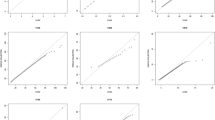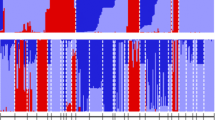Abstract
Between 1998 and 2008, numerous projects were conducted by the Canadian national genebank, Plant Gene Resources of Canada, for the regeneration, characterization and evaluation of the whole flax (Linum usitatissimum L.) germplasm collection. The whole collection comprised 3378 accessions and, according to the passport data, several of these were probably genetically very similar or even identical. Therefore, a subset of 381 accessions was selected that represented the diversity found in the whole collection. Sampling accessions from the whole collection was made using characterization and evaluation data and followed six different methods: (1) For seven qualitative characters, each unique combination of character expression was represented by three accessions; (2) for quantitative characters, a fixed number of accessions representing the lowest and highest observed values was included; (3) for stem fibre content, disease ratings, seed vigour and drought tolerance, a fixed number of accessions with desirable performance was included; (4) a subset of the 57 most distinct accessions based on RAPD markers was included; (5) a subset of 40 pure lines that were created based on extreme low and high values for 1000 seed weight, seed oil content and fatty acid profiles was included; (6) a subset of fibre flax cultivars of known relevance in European flax breeding and another subset of flax cultivars of known relevance for North American linseed breeding were included. The goal was to maximize the diversity available in a limited number of flax accessions by preserving the range of variation present in the whole collection, while improving evenness. The core collection was assembled in response to requests by flax breeders. This paper compares distribution parameters in the whole and core collections.



Similar content being viewed by others
References
Beuselinck PR, Steiner JJ (1992) A proposed framework for identifying, quantifying and utilizing plant germplasm resources. Field Crops Res 29:261–272
Bretting PK, Widrlechner MP (1995) Genetic markers and plant genetic resources management. Plant Breed Rev 13:11–86
Brown AHD (1989) Core collections: a practical approach to genetic resources management. Genome 31:818–824
Brown AHD (1995) The core collection at the crossroads. In: Hodgkin T, Brown AHD, van Hintum TJL, Morales EAV (eds) Core collections of plant genetic resources. Wiley, Chichester, pp 3–19
Brown AHD, Spillane C (1999) Implementing core collections—principles, procedures, progress, problems and promise. In: Johnson RC, Hodgkin T (eds) Core collections for today and tomorrow. International Plant Genetic Resources Institute, Rome, pp 1–9
Diederichsen A (2007) Ex-situ collections of cultivated flax (Linum usitatissimum L.) and other species of the genus Linum L. Genet Resour Crop Evol 54:661–678
Diederichsen A (2009) Taxonomical and morphological assessments of infraspecific diversity in cultivated flax (Linum usitatissimum L.). J Agric Rural Dev Trop Subtrop Suppl 92:33–51; http://www.upress.uni-kassel.de/online/frei/978-3-89958-680-0.volltext.frei.pdf
Diederichsen A, Fu YB (2008) Flax genetic diversity as the raw material for future success. In: FAO/ESCORENA (eds) Proceedings of the 2008 international conference on flax and other bast plants, Saskatoon, Canada, July 21–23, 2008, pp 270–280
Diederichsen A, Jones-Flory LL (2005) Accelerated aging tests with seeds of 11 flax (Linum usitatissimum) cultivars. Seed Sci Technol 33:419–429
Diederichsen A, Raney JP (2006) Seed colour, seed weight and seed oil content in flax (Linum usitatissimum L.) accessions held by Plant Gene Resources of Canada. Plant Breed 125:372–377
Diederichsen A, Raney JP (2008) Pure-lining of flax (Linum usitatissimum L.) genebank accessions for efficiently exploiting and assessing seed character diversity. Euphytica 164:255–273
Diederichsen A, Ulrich A (2009) Variability in stem fibre content and its association with other characteristics in 1177 flax (Linum usitatissimum L.) genebank accessions. Ind Crops Prod 30:33–39
Diederichsen A, Raney JP, Duguid SD (2006a) Variation of seed-coat mucilage in 16 flax cultivars and a flax world collection, and its relationship with seed weight and oil content. Crop Sci 46:365–371
Diederichsen A, Rozhmina TA, Zhuchenko AA, Richards KW (2006b) Screening for broad adaptation in 96 flax (Linum usitatissimum L.) accessions under dry and warm conditions in Canada and Russia. FAO/IPGRI Plant Genet Resour Newslett 146:7–14
Diederichsen A, Rozhmina TA, Kudrjavceva LP (2008) Variation patterns within 153 flax (Linum usitatissimum L.) genebank accessions based on evaluation for resistance to fusarium wilt, anthracnose and pasmo. Plant Genet Resour Charact Util 6:22–32
Dillman AC (1953) Classification of flax varieties, 1946. Technical Bulletin No. 1054. United States Department of Agriculture, Washington
Endresen DTF (2011) Utilization of plant genetic resources: a lifeboat to the gene pool (PhD Thesis). Copenhagen University, Faculty for Life Sciences, Department of Agriculture and Ecology. Lund University Press, Lund. http://goo.gl/pYa9x. Accessed 1 Aug 2012
FAO (2010) Second Report on the State of the World’s Plant Genetic Resources for Food and Agriculture. FAO, Rome. http://www.fao.org/agriculture/crops/core-themes/theme/seeds-pgr/sow/sow2/en/. Accessed 1 Aug 2012
FAO/IPGRI (1994) Genebank standards. FAO/IPGRI, Rome
Frankel OH (1984) Genetic perspectives of germplasm conservation. In: Arber WK, Llimensee K, Peacock WJ, Starlinger P (eds) Genetic manipulation: impact on man and society. Cambridge University Press, Cambridge, pp 161–170
Frankel OH, Brown AHD (1984) Plant genetic resources today: a critical appraisal. In: Holden JHW, Williams JT (eds) Crop genetic resources: conservation & evaluation. George Allen & Unwin, London, pp 249–257
Fu YB (2006) Redundancy and distinctness in flax germplasm as revealed by RAPD dissimilarity. Plant Genet Resour Charact Util 4:117–124
Hammer K (2001) Linaceae. In: Hanelt P, Institute of Plant Genetics and Crop Plant Research (eds) Mansfeld’s encyclopedia of agricultural and horticultural crops (Except Ornamentals), vol 2. Springer, Berlin, pp 1106–1108
Kenaschuk EO, Rowland GG (1995) Flax. In: Slinkard AE, Knott DR (eds) Harvest of gold: the history of field crop breeding in Canada. University of Saskatchewan, Saskatoon, pp 173–176
Kulpa W, Danert S (1962) Zur Systematik von Linum usitatissimum L. [On the systematics of Linum usitatissimum L.]. Kulturpflanze Beiheft 3:341–388
Mackay MC, Street K (2004) Focused identification of germplasm strategy–FIGS. Cereals. p 138–141. In: Black CK, Panozzo JF, Rebetzke GJ (eds) Proceedings of the 54th Australian cereal chemistry conference and the 11th wheat breeders’ assembly, Canberra, ACT. 21–24 September 2004. Royal Australian Chemical Institute, Melbourne, Australia
McCouch SR, McNally KL, Wang W, Sackville Hamilton R (2012) Genomics of gene banks: a case study in rice. Am J Bot 90:407–423
Ortiz R (2002) Not just seed repositories: a more pro-active role for gene banks. Gene Conserv 1:21–24
Skovmand B, Mackay MC, Street KA (2004) A new approach to locating and utilizing oat genetic resources. In: Peltonen-Sainio P, Topi-Hulmi M (eds) Proceedings of the 7th international oat conference, Agrifood Research Reports 51:33–37
Vaughan D, Jackson MT (1995) The core as a guide to the whole collection. In: Hodgkin T, Brown AHD, van Hintum TJL, Morales EAV (eds) Core collections of plant genetic resources. Wiley, Chichester, pp 229–249
Vavilov NI (1935) Botaniko-geografičeskie osnovy selekcii. [The phytogeographical basis for plant breeding]. (In Russian). In: Vavilov NI (ed) Teoretičeskie osnovy selekcii [Theoretical basis for plant breeding], Vol. 1. Sel’chozgiz, Moscow, Leningrad, pp 17–75
Acknowledgments
The financial support obtained for conducting several projects on flax germplasm from the Saskatchewan Flax Development Commission allowed for hiring several student helpers and we thank all of them. The very helpful comments by the anonymous reviewers are appreciated.
Author information
Authors and Affiliations
Corresponding author
Rights and permissions
About this article
Cite this article
Diederichsen, A., Kusters, P.M., Kessler, D. et al. Assembling a core collection from the flax world collection maintained by Plant Gene Resources of Canada. Genet Resour Crop Evol 60, 1479–1485 (2013). https://doi.org/10.1007/s10722-012-9936-1
Received:
Accepted:
Published:
Issue Date:
DOI: https://doi.org/10.1007/s10722-012-9936-1




